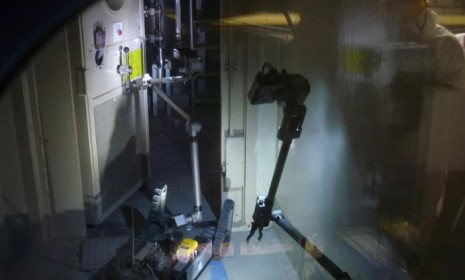The 'mighty' robots of Fukushima
A guide to the global crew of robots — including a hulking machine called the "Rescue Dragon" — that's going where humans fear to tread: Inside Japan's stricken nuclear plant

After several false starts, the Tokyo Electric Power Co. (Tepco) is starting to deploy a growing army of robotic helpers to restore sections of the crippled Fukushima Daiichi nuclear power facility that are too radioactive for humans. Initially, Japan lacked qualified robots (revealing a sizable hole in its renowned robotics expertise), so the first mechanical workers were imported from the U.S. and Europe. But the latest, the "mighty Enryu," is all Japanese. Let's meet some of Japan's robot saviors:
1. T-53 Enryu ("Rescue Dragon")
The original Enryu was created in 1995, as a search-and-rescue machine after the massive Kobe earthquake, though it wasn't really used until a 2007 quake. The 5-ton monster has two, six-jointed arms that can each lift debris weighing more than 200 pounds. It moves on bulldozer treads, and has a small bulldozer attachment on the front. At the Daiichi plants, its main job will be clearing rubble.
The Week
Escape your echo chamber. Get the facts behind the news, plus analysis from multiple perspectives.

Sign up for The Week's Free Newsletters
From our morning news briefing to a weekly Good News Newsletter, get the best of The Week delivered directly to your inbox.
From our morning news briefing to a weekly Good News Newsletter, get the best of The Week delivered directly to your inbox.
2. 510 PackBots
Made by the U.S. firm iRobot (most famous for its Roomba vacuum robot), the 60-pound PackBots have proved effective at defusing bombs and performing other combat-related duties for the U.S. military. For the Fukushima mission, iRobot outfitted a pair of PackBots — the first remote machines to enter the highly radioactive reactors — with cameras and sensors to gauge gamma radiation, temperature, and oxygen levels. Its maiden voyage inside reactors 1, 2, and 3 revealed frighteningly high radiation levels.
3. T-Hawk miniature helicopters
Another U.S.-made combat machine, Honeywell's T-Hawk unmanned aerial vehicle — a 17-pound machine that can hover up to 10,000 feet above the ground — is being used to take detailed video of the explosion-riddled reactors. French company Helipse also sent over three unmanned helicopters outfitted with an array of sensors. Watching the overhead videos from the flying robots gives you a "profoundly odd feeling," says Andrew Revkin in The New York Times. "It is utterly reminiscent of some of the opening scenes in Wall-E, in which a solitary automaton cleans up the massive mess left after humans have evacuated a polluted planet."
A free daily email with the biggest news stories of the day – and the best features from TheWeek.com
4. Bobcat and Talon
Anglo-American company QinetiQ has sent both its Bobcat T300 loaders and smaller Talon search-and-rescue robots to help in Fukushima. The Talon was used in the cleanup of the World Trade Centers after 9/11. Both types of machine can be operated from a mile away using Xbox 360 video game controllers. "It may seem odd to use Xbox 360 pads for such important work," says Patrick Morgan in Discover. But "unlike a game, there are no pause buttons, restarts, or extra lives at Fukushima," and "'game over' is both unthinkable and unimaginable."
Sources: CNET, BBC, Gizmodo, Japan Times, Popular Mechanics, LA Times, ieee Spectrum, NY Times, Ubergizmo, New Scientist
-
 Wilde Cambridge: home-away-from-home in a prime city spot
Wilde Cambridge: home-away-from-home in a prime city spotThe Week Recommends This laid-back aparthotel is the perfect base for a weekend of exploring
-
 The best alcohol-free alternatives for Dry January
The best alcohol-free alternatives for Dry JanuaryThe Week Recommends Whether emerging from a boozy Christmas, or seeking a change in 2026, here are some of the best non-alcoholic beers, wines and spirits to enjoy
-
 A lemon-shaped exoplanet is squeezing what we know about planet formation
A lemon-shaped exoplanet is squeezing what we know about planet formationUnder the radar It may be made from a former star